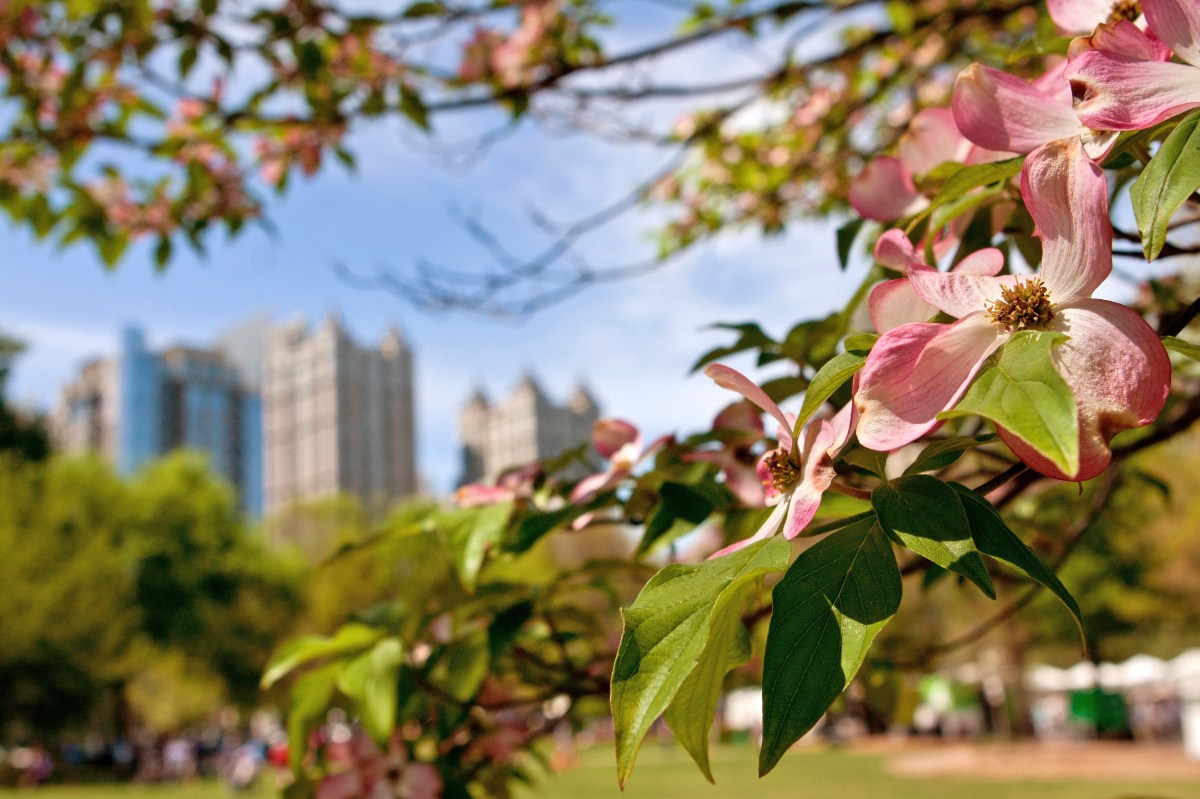
Come March, it’s time to get your lawn care tools out of the shed and reconnect with your yard. Here are 12 professional spring lawn care tips for Atlanta to get you started on a healthy lawn.
It all starts with getting your mower and trimmer ready for the new grass-cutting season.
- 1. Prepare the Lawn Equipment for a New Season
- 2. Give Your Yard a Spring Cleanup
- 3. Take a Soil Test
- 4. Apply Herbicides to Treat Lawn Weeds
- 5. Consider Scalping Your Lawn for Faster Growth
- 6. Start Mowing
- 7. Aerate During Active Growth
- 8. Overseed Warm-Season Grasses
- 9. Fertilize the Lawn by Grass Type
- 10. Irrigate According to the Weather
- 11. Kill Spring Pests
- 12. Prevent and Treat Spring Lawn Diseases
- FAQ
1. Prepare the Lawn Equipment for a New Season
Check your lawn equipment to ensure your mower, trimmer, and other lawn care tools are in good working order.
For example, you should sharpen your mower blades before you mow your lawn for the first time. You also should re-string your weed eater, if it needs that.
My Tip: If you don’t do this yourself (like me), have them serviced by a local small equipment shop. However, many shops are busy at the beginning of a new season, so plan accordingly to have it serviced a couple of weeks before you need it so it’s ready to go when you are.
See Related:
– 6 Essential Lawn Care Tools for Homeowners
– How to Change the Oil in a Lawn Mower
– How to Clean and Change a Lawn Mower Air Filter
2. Give Your Yard a Spring Cleanup
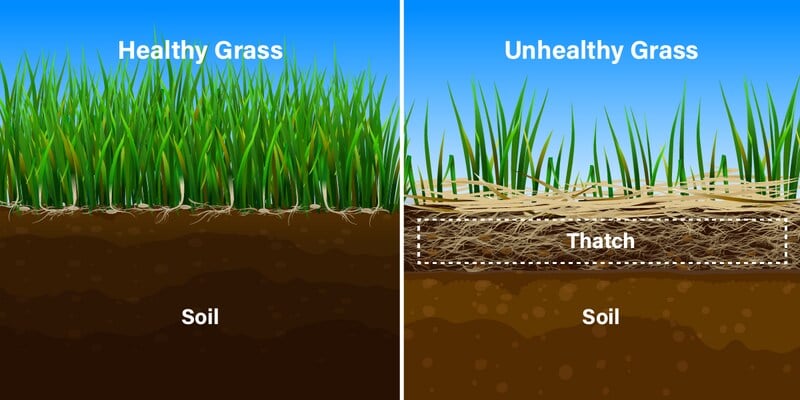
Spring cleaning is not just for your house, but should extend to your yard. A clean yard leads to healthy, thriving grass, so start cleaning with these tasks:
- Collect branches, pet waste, rocks, and garbage left behind during winter.
- Rake fallen leaves and other debris and bag them.
- Trim and prune trees and shrubs.
- Clean up flower beds.
If necessary, remove thatch – the collection of dead and living roots, stems, and runners that form between the grass and soil – to help grass grow faster and healthier. The best time to remove thatch from your Atlanta lawn is during the growing season:
- Early spring for tall fescue and other types of cool-season grass
- Late spring to early summer for warm-season grasses (after the second mowing of the year, not including scalping)
| If a spring lawn cleanup is too much work or your yard is too large, LawnStarter’s leaf removal pros can take spring cleanup off your to-do list. Our pros completed nearly 12,000 leaf removal jobs last year at an average cost of $158 per job, with an average rating of 4.3. |
See Related:
–How to Dethatch Your Lawn
–5 Best Ways to Clean Up Leaves in Your Yard
–How to Remove Leaves From Mulch and Flower Beds
–Pruning 101: How to Trim Bushes, Hedges, and Shrubs
3. Take a Soil Test
If you haven’t tested your soil as part of a fall lawn care checklist, spring is the next best time to check your soil’s pH level. It should be between 5.5 and 6.5 to support nutrient absorption and healthy grass.
Acidic soil reduces fertilizer efficiency by up to 60%, while alkaline soil makes the grass more vulnerable to diseases.
You can test your soil at your local Extension office. For instance, at the Fulton County Extension Office a basic soil test is $12. The results include data about soil pH and the macronutrients and micronutrients your lawn needs.
Pro Tip: Atlanta soil usually gets acidic and requires granular lime treatment.
See Related:
–How to Tell If Your Lawn Needs Lime
–How to Test the Soil pH of Your Lawn
–How to Prepare a Soil Sample (4 Easy Steps)
–How to Use a Soil Test Kit
–9 Reasons Why Soil Testing Is Important for the Lawn
4. Apply Herbicides to Treat Atlanta Lawn Weeds
Proper weed control helps keep weeds at bay. Come spring, you can:
- Fight winter annual weeds with post-emergent herbicides.
- Prevent summer annual and perennial weeds with pre-emergent herbicides.
Post-Emergent Herbicides and Winter Weeds
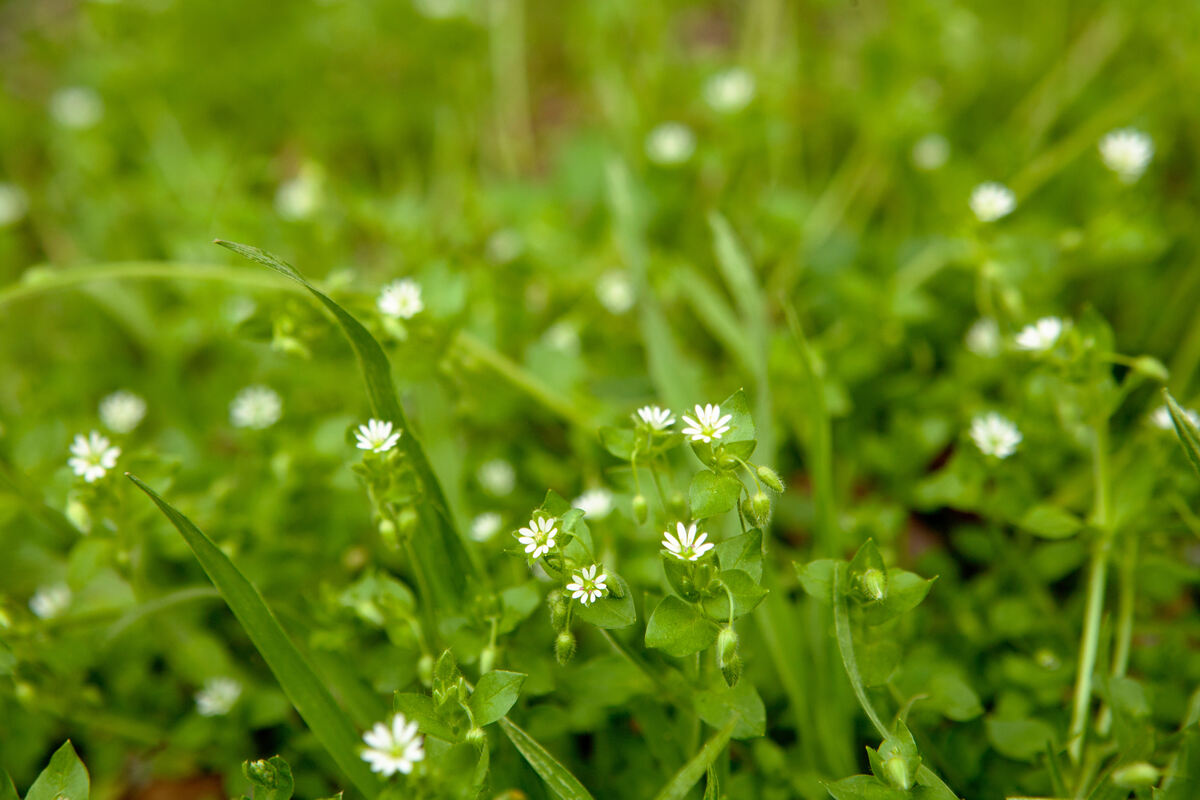
Winter annual weeds germinate in late summer or early fall, grow during winter, and die in late spring or early summer. Among the most common winter weeds are:
- Annual bluegrass (Poa annua)
- Speedwell
- Chickweed
- Henbit
- Swinecress
Remove them before they’re able to spread their seeds. Apply a post-emergent herbicide, or hand-pick them if there are only a few.
Pre-Emergent Herbicides and Summer Weeds
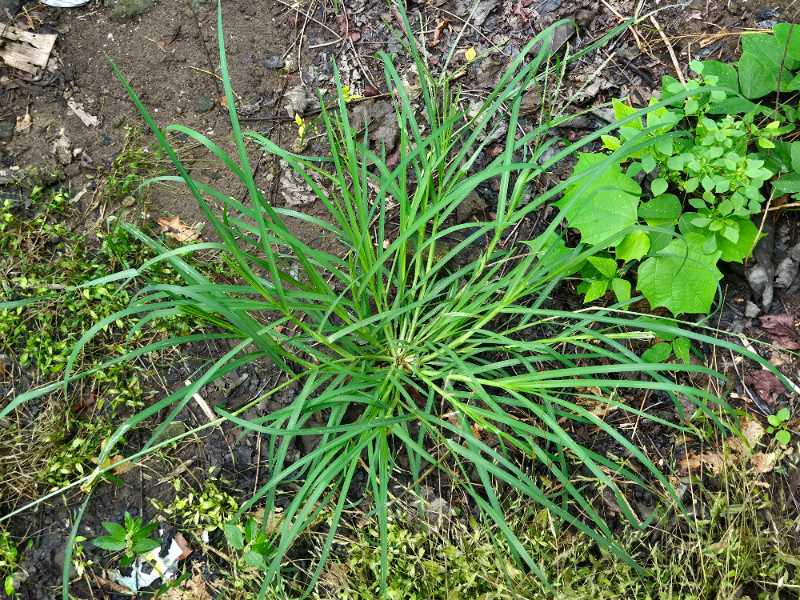
Spring is also the time to prevent summer annual weeds, which germinate in spring. The most common summer weeds in Atlanta lawns are:
- Crabgrass
- Goosegrass
- Lespedeza
- Prostrate knotweed
To prevent summer annual weeds from sprouting, apply a pre-emergent herbicide when the soil temperature is 50 F to 55 F and the seeds haven’t germinated yet. Pre-emergent herbicides are usually granular and easily applied around the yard using a spreader.
Pro Tip: When applying herbicides, always wear protective equipment, wait for a day without rain or wind, and keep children and pets away from the lawn.
See Related:
–Common Weeds in Georgia Lawns and Gardens
–When to Apply Pre-Emergent Herbicide
–How to Choose The Right Lawn Spreader
–Types of Post-Emergent Herbicides
5. Consider Scalping Your Lawn for Faster Growth
Scalping is cutting the grass much lower than usual. It’s best done from early March to mid-April when the grass leaves dormancy. Scalping removes the layer of dead grass blades and has valuable benefits for your lawn:
- Free soil warms up easier, absorbs water faster, and speeds up grass growth.
- Removing dead grass blades prevents thatching.
- Scalping helps you see and treat uneven areas and dead spots.
In Atlanta, you can scalp Bermudagrass and Zoysia, but not tall fescue, centipede, or St. Augustine. You can hire an Atlanta lawn care pro to scalp the lawn or DIY it by following our scalping guide.
6. Start Mowing
For a tall fescue lawn, start mowing when it gets 2.5 to 3 inches tall, usually around mid-March, and cut it to keep it at 2 inches for the entire spring. Warm-season grasses start later, so Bermuda, centipede, St. Augustine, and Zoysia lawns need mowing as soon as they start greening up around March or April.
Here’s how short you should mow Atlanta’s most common turfgrasses in spring:
| Turfgrass Type | Spring Mowing Height |
| Centipedegrass | 1 inch |
| Hybrid Bermuda | 1 inch |
| St. Augustinegrass | 2.5 inches |
| Zoysiagrass | 1 inch |
| Tall fescue | 2 inches |
My Tip: Weather is tricky in Atlanta, so spring can remain cool longer or warm up earlier, affecting grass growth. Therefore, to determine when to start mowing your lawn, keep an eye on when you see new growth in your yard.
See Related: 5 Best Grass Types for Your Atlanta, GA Lawn
7. Aerate During Active Growth
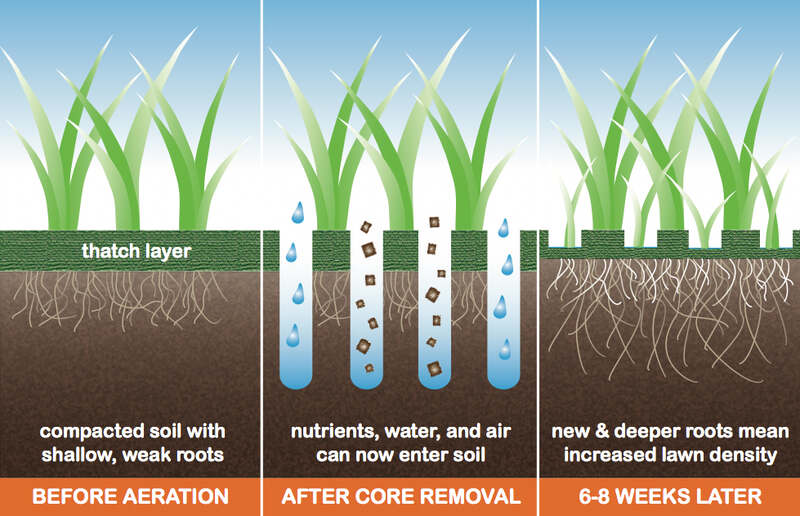
Aerating once a year improves drainage by creating openings in the soil. The best time to aerate is when your grass is actively growing:
- March and April for tall fescue and other cool-season grasses
- May through June for warm-season grasses
The best way to aerate a lawn is when the soil is moist after a light rain, using a core aerator (you can rent one from your local lawn and garden center). Or find a landscaping company in Metro Atlanta to aerate your lawn for you.
8. Overseed Warm-Season Grasses
If your lawn has bare areas or thinning grass, you need to overseed your lawn. The perfect time to overseed a warm-season lawn is in May through June when these types of grass are actively growing in the North Georgia climate. Overseed tall fescue a little earlier, around March to April, after it greens up.
Seeds germinate and grow best on a clean lawn that has been raked, mowed, and aerated. See our step-by-step guide for more information: How to Overseed a Lawn in 8 Simple Steps.
Pro Tip: When overseeding the lawn, use a starter fertilizer instead of a standard formula, and apply it before you spread any grass seed.
See Related:
–Overseeding vs. Reseeding: What’s Best for Your Lawn?
–5 Clear Signs You Need to Overseed Your Lawn
–Can You Fertilize and Overseed at the Same Time? (3 Reasons Not To)
9. Fertilize the Lawn by Grass Type
Spring is one of the best times to apply fertilizer on your lawn. For optimum results, use fertilizers during your grass’s growing season:
- March for tall fescue and other cool-season grasses; if necessary, also fertilize tall fescue in May.
- May for Bermuda, Zoysiagrass, St. Augustinegrass, centipede, and other warm-season grasses.
Look for a granular, slow-release, high nitrogen fertilizer to:
- Support new growth
- Ensure nutrients are delivered gradually for many weeks
- Prevent grass burns from excessive exposure to nitrogen
You can fertilize your lawn yourself, or hire a LawnStarter fertilizer service to do it for you.
See Related:
–7 Common Fertilizer Mistakes to Avoid
–How to Choose the Right Lawn Fertilizer
–What is Organic Fertilizer?
–5 Tell-Tale Signs Your Lawn Needs Fertilizer
–Can You Over-Fertilize Your Lawn?
10. Irrigate According to the Atlanta Weather
Start irrigating the grass once you apply the first fertilizer feeding, and ensure it receives 1 inch of water per week in 1-2 watering sessions. If it rains, stop irrigating or reduce the amount. The soil should be moist, but the grass should have as little water on the blades as possible.
Avoid superficial and frequent watering, as this leads to:
- Shallow grass roots — makes the grass vulnerable to drought
- Prolonged exposure to moisture — increases the risk of fungi and grass diseases
- Increased evaporation — less water gets to the grass roots
The best time to water your lawn is in the morning, before 9 a.m. This gives the soil enough time to absorb as much water as it needs. The rest evaporates with the sun, keeping the grass safe from fungi.
Water clay soils in short intervals, about 15 minutes each, with 30 minutes to an hour of rest time in between. This allows the water to sink into the soil without pooling or runoff.
11. Kill Spring Pests
Warmer weather also brings to life common Atlanta lawn pests that can hurt your lawn, such as mole crickets, spittlebugs, and fire ants.
Keep your lawn clean, healthy, and adequately mowed to prevent pest infestation. Hire a LawnStarter lawn treatment pro to remove active infestations effectively.
12. Prevent and Treat Atlanta Spring Lawn Diseases

The most common lawn disease infestations to watch for during an Atlanta spring are:
| Spring Lawn Disease (Active Months) | What to Look For |
| Fairy rings (March to November) | ● Rings of brown and wilted dead grass ● Rings of tall, dark green grass |
| Brown patch (February to June) | ● Rings or circular patches of blighted turfgrass ● Reddish-brown or black leaf spots or “Smoke-rings” – thin, brown borders around the diseased patches ● Leaves pull out easily; roots are not affected |
| Large patch (March to May) | ● Circular patches of brownish turf, orange at the periphery ● Leaves dieback from the tip toward the base |
| Dollar spot (February to December) | ● Sunken, circular patches of grass, brown to straw color, measuring up to several inches ●Small lesions on the leaves, yellow-green to straw color, with a reddish-brown border |
| Leaf spot/Melting out (March to November) | ● Leaf blades and sheath have purplish-brown to black spots with tan centers ● The lower leaves are withered and blighted |
| Anthracnose (April to July) | ● Reddish-brown spots surrounded by a yellow halo ● Basal stem and leaf sheath rot ● Infected shoots detach easily |
| Gray leaf spot (June to September) | ● Oval or elongated bluish-gray spots on St. Augustinegrass; the mature lesions are tan to gray, with depressed centers and irregular, purple-to-brown margins ● Symptoms are similar to melting out disease in cool-season grasses |
| Pythium root rot (year-round) | ● Yellow, irregularly shaped patches ● Turfgrass is thin, off-color, and slow-growing |
| Slime mold (March to May, September to November) | ● Pinhead-sized fruiting bodies on grass blades and stems in circular to irregular patches 1 to 30 inches in diameter ● Slimy or crusty substance covering the grass |
Fungal diseases thrive in lawns with:
- Compacted soil with poor drainage
- Excessive moisture
- Build-up of organic matter, either thatch or extensive tree and shrub roots still in the ground
- Unbalanced soil with not enough nutrients or an excessive amount of nitrogen
To prevent or correct these conditions naturally, aerate to relieve compaction and help water drain properly, dethatch or remove roots to manage excess organic matter, and fertilize according to your soil test report.
To treat fungal diseases, there are a variety of lawn fungus treatments available in both liquid and granular form. It’s important to choose a treatment designed specifically for your lawn fungus, and apply it according to the treatment’s directions.
While a fungal disease is active on your lawn, AVOID:
- Core aeration
- Herbicides
- Fast-release liquid fertilizers
- Foot traffic across the yard (it stresses the grass and can spread the infection)
Bag the clippings and dispose of them while the lawn is in treatment to avoid spreading the fungi.
If necessary, contact a LawnStarter lawn treatment professional to help you identify the disease affecting your property and apply the proper fungicides.
FAQ
Taking care of your Atlanta lawn in the spring is necessary to have a strong, healthy lawn all year long. Skipping on spring lawn care could lead to dead patches, weed growth, and pest invasions — all of which could ruin your grass.
If you want to switch to eco-friendly lawn care maintenance, use organic fertilizer. Organic formulas are lower in nitrogen than synthetic alternatives, so you’ll need to apply more. They are also slow-release and feed the lawn gradually, preparing the soil and plants for the summer.
Hire a Pro to Enjoy Your Beautiful Atlanta Lawn
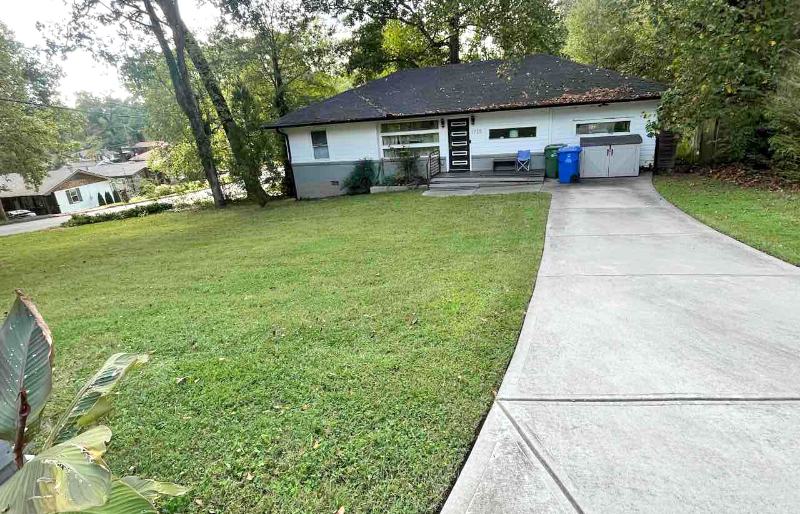
Taking care of your Atlanta lawn correctly in the spring sets the stage for a lush, green lawn in the summer. It’s also a lot of work; you need to do it right, so don’t hesitate to get help. Hire one of LawnStarter’s Atlanta lawn care pros to mow, remove leaves, or aerate your lawn and enjoy watching your grass grow healthy and thick without the extra work.
Read Next:
–9 Summer Lawn Care Tips for Atlanta, GA
–8 Tips for Maintaining Your Atlanta Lawn
–7 Crucial Winter Lawn Care Tips for Atlanta
Main Image: Pink dogwood tree blossoms frame Atlanta in springtime. Photo Credit: blueiz60 / Adobe Stock